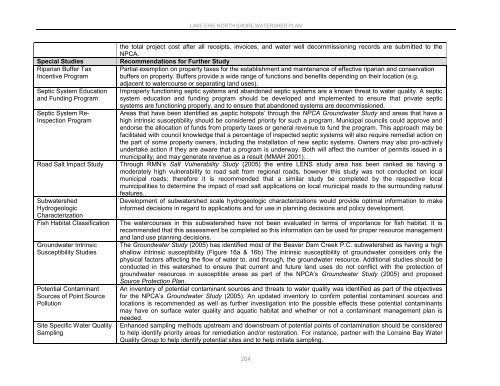Lake Erie North Shore Watershed Plan - Niagara Peninsula ...
Lake Erie North Shore Watershed Plan - Niagara Peninsula ...
Lake Erie North Shore Watershed Plan - Niagara Peninsula ...
You also want an ePaper? Increase the reach of your titles
YUMPU automatically turns print PDFs into web optimized ePapers that Google loves.
LAKE ERIE NORTH SHORE WATERSHED PLAN<br />
Special Studies<br />
Riparian Buffer Tax<br />
Incentive Program<br />
Septic System Education<br />
and Funding Program<br />
Septic System Re-<br />
Inspection Program<br />
Road Salt Impact Study<br />
Subwatershed<br />
Hydrogeologic<br />
Characterization<br />
Fish Habitat Classification<br />
Groundwater Intrinsic<br />
Susceptibility Studies<br />
Potential Contaminant<br />
Sources of Point Source<br />
Pollution<br />
Site Specific Water Quality<br />
Sampling<br />
the total project cost after all receipts, invoices, and water well decommissioning records are submitted to the<br />
NPCA.<br />
Recommendations for Further Study<br />
Partial exemption on property taxes for the establishment and maintenance of effective riparian and conservation<br />
buffers on property. Buffers provide a wide range of functions and benefits depending on their location (e.g.<br />
adjacent to watercourse or separating land uses).<br />
Improperly functioning septic systems and abandoned septic systems are a known threat to water quality. A septic<br />
system education and funding program should be developed and implemented to ensure that private septic<br />
systems are functioning properly, and to ensure that abandoned systems are decommissioned.<br />
Areas that have been identified as „septic hotspots‟ through the NPCA Groundwater Study and areas that have a<br />
high intrinsic susceptibility should be considered priority for such a program. Municipal councils could approve and<br />
endorse the allocation of funds from property taxes or general revenue to fund the program. This approach may be<br />
facilitated with council knowledge that a percentage of inspected septic systems will also require remedial action on<br />
the part of some property owners, including the installation of new septic systems. Owners may also pro-actively<br />
undertake action if they are aware that a program is underway. Both will affect the number of permits issued in a<br />
municipality, and may generate revenue as a result (MMAH 2001).<br />
Through RMN‟s Salt Vulnerability Study (2005) the entire LENS study area has been ranked as having a<br />
moderately high vulnerability to road salt from regional roads, however this study was not conducted on local<br />
municipal roads; therefore it is recommended that a similar study be completed by the respective local<br />
municipalities to determine the impact of road salt applications on local municipal roads to the surrounding natural<br />
features..<br />
Development of subwatershed scale hydrogeologic characterizations would provide optimal information to make<br />
informed decisions in regard to applications and for use in planning decisions and policy development.<br />
The watercourses in this subwatershed have not been evaluated in terms of importance for fish habitat. It is<br />
recommended that this assessment be completed so this information can be used for proper resource management<br />
and land use planning decisions.<br />
The Groundwater Study (2005) has identified most of the Beaver Dam Creek P.C. subwatershed as having a high<br />
shallow intrinsic susceptibility (Figure 16a & 16b) The intrinsic susceptibility of groundwater considers only the<br />
physical factors affecting the flow of water to, and through, the groundwater resource. Additional studies should be<br />
conducted in this watershed to ensure that current and future land uses do not conflict with the protection of<br />
groundwater resources in susceptible areas as part of the NPCA‟s Groundwater Study (2005) and proposed<br />
Source Protection <strong>Plan</strong>.<br />
An inventory of potential contaminant sources and threats to water quality was identified as part of the objectives<br />
for the NPCA‟s Groundwater Study (2005). An updated inventory to confirm potential contaminant sources and<br />
locations is recommended as well as further investigation into the possible effects these potential contaminants<br />
may have on surface water quality and aquatic habitat and whether or not a contaminant management plan is<br />
needed.<br />
Enhanced sampling methods upstream and downstream of potential points of contamination should be considered<br />
to help identify priority areas for remediation and/or restoration. For instance, partner with the Lorraine Bay Water<br />
Quality Group to help identify potential sites and to help initiate sampling.<br />
204
















